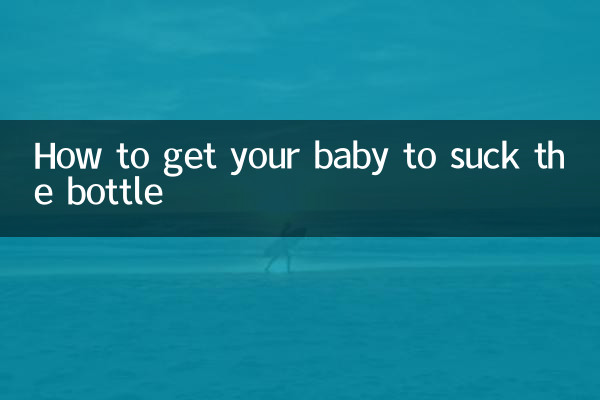How to get your baby to suck the bottle
On the road of parenting, getting your baby to accept a bottle smoothly is a common but troublesome problem. Whether switching from breast milk to bottle feeding or mixed feeding, many parents will encounter situations where their babies refuse bottles. In order to help parents solve this problem, we searched the hot topics and content on the Internet in the past 10 days and summarized some practical methods and data for your reference.
Why does my baby refuse the bottle?

There are various reasons why babies refuse bottles. It may be that the shape and material of the nipple are inappropriate, the feeding posture is incorrect, or even the baby is resistant to the bottle. Here are some common causes and solutions:
| Reason | Solution |
|---|---|
| The shape of the nipple is inappropriate | Try different nipple shapes, such as wide or standard diameter |
| The pacifier material is uncomfortable | Choose a pacifier made of silicone or latex. Silicone is more durable and latex is softer. |
| Incorrect feeding posture | Imitate breastfeeding posture and maintain a 45-degree angle for feeding |
| Baby's resistance | Let other family members try feeding to avoid mother feeding herself |
How to get your baby to accept a bottle?
Based on recent hot parenting topics, we’ve put together some practical tips to help your baby make a smooth transition to bottle feeding:
1.Choose the right time: Try bottle feeding when your baby is emotionally stable and not too hungry, and avoid force-feeding when your baby is extremely hungry or irritable.
2.Gradually introduce the bottle: You can first let the baby get familiar with the bottle, such as filling the bottle with water or juice, so that the baby can slowly adapt to the existence of the bottle.
3.imitate breastfeeding: Use a pacifier with a flow rate close to that of breast milk, and imitate the posture and rhythm of breast milk during feeding to reduce the baby's resistance.
4.Suitable temperature: Make sure the temperature of the milk is close to the temperature of breast milk (approximately 37°C) to avoid overcooling or overheating causing baby discomfort.
5.Patient guidance: If the baby refuses at first, don’t force it. You can try it multiple times and gradually increase the number of bottle feedings.
Recommended popular baby bottle brands
Based on recent consumer feedback and sales data, here are some highly recommended baby bottle brands:
| brand | Features | price range |
|---|---|---|
| Pigeon | The nipple is soft and tastes close to breast milk | 50-150 yuan |
| Philips Avent | Anti-flatulence design reduces baby spitting up milk | 80-200 yuan |
| So great | Wide diameter design for easy cleaning | 100-250 yuan |
| NUK | Bionic pacifier, suitable for babies of different ages | 60-180 yuan |
FAQ
1.What should I do if my baby keeps refusing the bottle?You can try changing to a different brand of bottle or nipple, or adjusting the feeding time and environment. If the problem persists, it is recommended to consult a pediatrician or parenting specialist.
2.Can bottle feeding cause nipple confusion in babies?If done correctly, bottle feeding will not cause nipple confusion. Choosing a nipple that approximates the flow rate of breast milk and paying attention to feeding position can reduce the possibility of confusion.
3.How to control the frequency of bottle feeding?Adjust feeding frequency according to your baby's age and needs. Newborns are usually fed every 2-3 hours. As the baby grows, the interval can be gradually extended.
Conclusion
Getting your baby to accept a bottle is a process that requires patience and skill. By choosing the right bottle, adjusting feeding methods, and being guided step by step, most babies can successfully transition to bottle feeding. We hope that the methods and data provided in this article can help parents solve this problem and make the journey of parenting easier and more enjoyable.

check the details

check the details